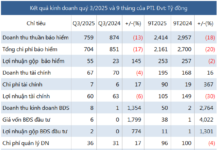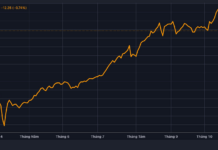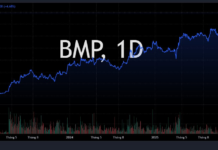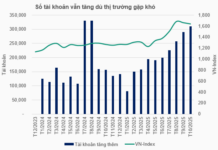
Deputy Governor Pham Thanh Ha of the State Bank of Vietnam (SBV) explains the reasons for the low credit growth in the early months of the year and proposes some solutions – Photo: VGP/Nhat Bac |
This is the opinion of Deputy Governor Pham Thanh Ha when analyzing the issue of credit growth at the regular government press conference in February.
Deputy Governor Pham Thanh Ha said: Regarding the credit growth policy in 2024, since the end of 2023, the SBV has determined an appropriate credit level that is in line with the economic growth target and inflation control to achieve a credit growth rate of about 15% in 2024. Based on that, the State Bank has allocated all credit targets to credit institutions on December 31st so that credit institutions can proactively plan for credit growth.
The SBV has publicly announced the allocation principles and distributed the credit targets to all credit institutions.
In the first two months of 2024, the SBV has observed that credit growth is slower compared to the same period in previous years, despite ample liquidity. The growth rate of credit is not keeping up with the same period in previous years.
The SBV leadership stated that the general reason is due to seasonal factors. Specifically, in the fourth quarter, economic activities usually become more vibrant, leading to more active lending activities. In the last month of 2023, credit growth was very strong at around 4%. However, in January and February, which are the months of the Lunar New Year, credit activities are expected to decrease and lending activities will not grow as much as in the previous fourth quarter.
In addition, this year there is another factor, which is that the global economy has not yet recovered and our major markets have not developed strongly, which affects output, exports. Meanwhile, the domestic market is still difficult, leading to a decrease in credit demand.
The SBV has implemented various solutions to promote credit growth for credit institutions, such as: Issuing directives to credit institutions to focus on promoting credit growth, streamlining and simplifying lending procedures to enhance the accessibility of capital for customers; focusing on enhancing digital transformation in credit processes to increase access to capital and expand banking credit activities.
Deputy Governor Pham Thanh Ha affirmed that the SBV will continue to review the documents according to the new Credit Institutions Law. The SBV will review the documents, decrees, and guidelines to ensure necessary adjustments are made to increase the accessibility of credit capital for borrowers.
Therefore, the SBV has made and is making many efforts and solutions to overcome difficulties for production and business activities, and boost credit growth.
“For lenders, liquidity is abundant and banks are ready to provide capital to the economy. However, there needs to be a coordinated policy from relevant agencies,” emphasized Mr. Pham Thanh Ha.
The representative of the SBV believes that it is necessary to improve the effectiveness of funds such as credit insurance funds for small and medium-sized enterprises, funds for the development of small and medium-sized enterprises, to enhance the credit access of these enterprises.
Regarding borrowers, the SBV also encourages businesses to actively implement restructuring measures, have more feasible investment or business projects, prove the feasibility of their projects; transparency, enhance financial capacity for lenders (credit institutions, commercial banks) to appraise and provide loan services to borrowers conveniently in the future.
“We have passed 2 months, credit in January decreased, in February it decreased less because the credit demand in February increased. Therefore, credit growth next month has already shown growth. We will continue to monitor the growth rate of March, the first quarter, and the following months to have specific solutions to promote credit growth, support borrowers, and promote economic growth,” said Deputy Governor Pham Thanh Ha.
Earlier, at the online conference of the entire industry on enhancing bank credit and promoting economic growth in 2024, leaders of the commercial banks also shared about credit growth. Mr. Nguyen Thanh Tung, CEO of Vietcombank, said that credit decreased due to slow growth in retail credit and real estate credit, and new licensed projects are still few or encountering legal obstacles. Besides, the payment of international trade financing loans is concentrated on the occasion of the Gregorian New Year to serve the demand for imported goods. FDI customers tend to repay their debts at the end of the year, due to the common psychology of enterprises and people being reluctant to borrow…
According to Mr. Tran Long, Deputy CEO of BIDV, the reason for the credit decline in the first month of the year is due to the weak absorption of capital by the economy. The economy still faces many challenges, groups of industries are slow in recovery growth, and the export market is facing many difficulties at the present time.
Further discussing this issue with the press, Mr. Pham Nhu Anh, CEO of Military Commercial Joint Stock Bank (MB), analyzed the differences in credit growth at the beginning of 2024. Specifically, in previous years, at the end of the year, credit demand was high, and at that time, banks were “quite strained” in credit capacity, so the demand was “transferred” to be resolved in January, leading to a relatively high credit growth rate at the beginning of the year.
However, in 2023, when the credit growth capacity was relatively comfortable, credit demand was met, by December 31st, individual and corporate debts were settled and basically resolved in 2023, so the loan demand in January was low. Some banks have more people paying debts than borrowing, which reduces the credit growth rate in January 2024.
“It is predicted that after the Lunar New Year, when investment, production, and business activities return to vibrancy, the demand will gradually increase. Credit in January and February decreases, in March, it recovers, and it may grow faster in the second quarter of 2024,” said Mr. Pham Nhu Anh.
Dong Tu





































